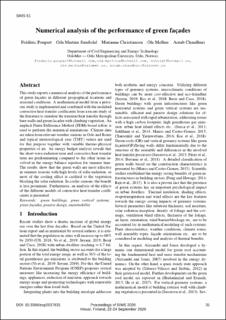| dc.contributor.author | Poupart, Frédéric | |
| dc.contributor.author | Martine, Oda | |
| dc.contributor.author | Christiansen, Sundsdal Marianne | |
| dc.contributor.author | Melhus, Ole | |
| dc.contributor.author | Chaudhuri, Arnab | |
| dc.date.accessioned | 2021-09-01T08:44:08Z | |
| dc.date.available | 2021-09-01T08:44:08Z | |
| dc.date.created | 2021-03-10T18:49:04Z | |
| dc.date.issued | 2021-03-03 | |
| dc.identifier.isbn | 978-91-7929-731-2 | |
| dc.identifier.issn | 1650-3686 | |
| dc.identifier.issn | 1650-3740 | |
| dc.identifier.uri | https://hdl.handle.net/11250/2772148 | |
| dc.description.abstract | This study reports a numerical analysis of the performance of green façades in different geographical locations and seasonal conditions. A mathematical model from a previous study is implemented and combined with the modified convective heat transfer coefficients from a recent study of the literature to simulate the transient heat transfer through bare walls and green facades with climbing vegetation. An implicit Finite Difference Method (FDM) based solver is used to perform the numerical simulations. Climate data are taken from relevant weather stations in Oslo and Rome and typical meteorological year (TMY) values are used for this purpose together with variable thermo-physical properties of air. An energy budget analysis reveals that the short-wave radiation term and convective heat transfer term are predominating compared to the other terms involved in the energy balance equation for summer time. The results show that the green walls are most effective in summer seasons with high levels of solar radiation, as most of the cooling effect is credited to the vegetation blocking the solar radiation. In cooler seasons, the benefit is less prominent. Furthermore, an analysis of the effects of the different models of convective heat transfer coefficients is presented. | en_US |
| dc.language.iso | eng | en_US |
| dc.publisher | Linköping University Electronic Press | en_US |
| dc.relation.ispartofseries | Linköping Electronic Conference Proceedings;No. 176: Proceedings of The 61st SIMS Conference on Simulation and Modelling, SIMS 2020 | |
| dc.rights | Navngivelse 4.0 Internasjonal | * |
| dc.rights.uri | http://creativecommons.org/licenses/by/4.0/deed.no | * |
| dc.subject | Green buildings | en_US |
| dc.subject | Green vertical systems | en_US |
| dc.subject | Green façades | en_US |
| dc.subject | Passive design | en_US |
| dc.subject | Sustainability | en_US |
| dc.title | Numerical analysis of the performance of green façades | en_US |
| dc.type | Conference object | en_US |
| dc.description.version | publishedVersion | en_US |
| dc.rights.holder | © 2020 Scandinavian Simulation Society | en_US |
| cristin.ispublished | true | |
| cristin.fulltext | original | |
| cristin.qualitycode | 1 | |
| dc.identifier.doi | https://doi.org/10.3384/ecp2017631 | |
| dc.identifier.cristin | 1897110 | |
| dc.source.journal | Linköping Electronic Conference Proceedings | en_US |
| dc.source.issue | 176 | en_US |
| dc.source.pagenumber | 31-38 | en_US |

